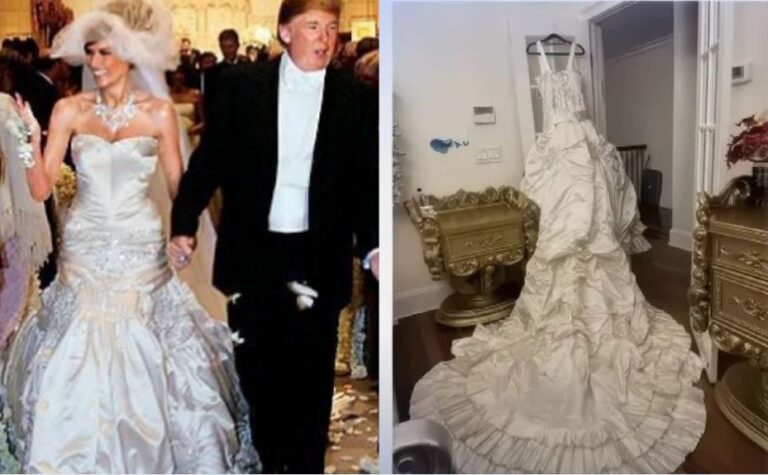Melania Trump’s wedding gown is in the news again, and instead of waning, the interest in it appears to be increasing. Even at the time, the custom Dior creation was considered a particularly daring fashion statement when she wore it to her wedding to Donald Trump at Mar-a-Lago in 2005. It was an unreserved celebration of skill, prestige, and drama that John Galliano created for Christian Dior.
The bridal fashion industry has seen a noticeable shift toward minimalism over the years, but this dress, which is a stunning example of maximalist elegance, is still dripping with pearls and Swarovski crystals. The gown, which weighed almost 60 pounds and was made of 300 feet of tulle, was famously photographed by Mario Testino for the February 2005 cover of Vogue. With its elegant lighting and composed posture, that editorial shot portrayed Melania as both a bride and a symbol of high-end fashion.
| Attribute | Details |
|---|---|
| Full Name | Melania Knauss Trump |
| Date of Birth | April 26, 1970 |
| Nationality | Slovenian-American |
| Profession | Former Model, Businesswoman, Former First Lady of the United States |
| Spouse | Donald J. Trump (Married on January 22, 2005) |
| Designer of Wedding Dress | John Galliano for Christian Dior |
| Dress Material | Ivory Duchesse Satin, Swarovski Crystals, Tulle |
| Estimated Original Cost | $100,000 to $200,000 |
| Dress Weight | Approximately 60 pounds |
The dress purportedly resurfaced on eBay in recent days, where a seller claiming to have bought it for her own wedding in 2010 put it up for a starting bid of $45,000. Her description indicates that she added straps, adjusted the bodice, and reinforced it with more satin and embroidery in order to make the dress fit her size. Even though these shifts make sense, they also bring up important issues regarding provenance and originality, particularly in a time when imitation and couture are frequently confused by replicas.
It is much more difficult to confirm the gown’s legitimacy in the absence of a certificate of authenticity. However, the listing received thousands of views in a single day, demonstrating how strongly this specific gown continues to captivate the public’s attention. Pop culture analysts, fashion bloggers, and bridal historians have all offered their opinions; some have even likened the changes to reediting a masterpiece painting. Even though the revised version is obviously different, its aura is still incredibly powerful at sparking conversation.
The ongoing attention this dress receives is especially helpful to high-end bridal designers. It says a lot about how timeless fashion storytelling is. This is a cultural artifact, not just a wedding gown. It captures a time when brides were supposed to make a big statement about their ambition and wealth, just as loudly as they did about their love and devotion. Galliano used deliberate embellishment to create a dress that did just that—it was aesthetically striking, extravagantly expensive, but painstakingly made.
The gown may appear heavy by today’s standards, both aesthetically and practically. Nonetheless, it was a logical progression of Melania’s identity given her public persona and aesthetic tastes. Being the wife of a man who was firmly rooted in grandeur and branding, Melania’s appearance had to represent both her own style and their shared values. Celebrities like Paris Hilton and Priyanka Chopra have since imitated this dress-persona synergy, as evidenced by their wedding attire, which echoed similar scale and embellishment elements.
The reintroduction of Melania’s gown into a rapidly democratizing fashion industry is what makes it so inventive. Even iconic dresses can become affordable, if not aspirationally, in the era of online resale and secondhand couture platforms. It’s remarkably similar to how fashion myths change that the dress, altered or not, might now be hanging in another woman’s closet. They begin as exclusive and conclude as shared.
These days, sellers turn their closets into miniature exhibits by forming strategic alliances with websites such as eBay. The intimate, clickable, and interpretive Melania gown, showcasing iPhone photos and cropped closeups, comes to life once more on an auction page rather than in a museum or archival vault. This change illustrates how everyday users—rather than historians—are renegotiating bridal legacy.
Melania’s fashion choices during her time as First Lady were frequently analyzed for meaning, sometimes unjustly and frequently compulsively. However, none of her White House looks were as iconic as her Dior wedding dress. Her most iconic fashion moment is still that one dress. The timing is especially telling because it’s resurfacing at a time when society as a whole is reevaluating wealth, excess, and identity.
The long shadow cast by the dress has influenced designers’ expectations. Melania’s dress stands out as a reminder that bridal fashion can still be theatrical without devolving into parody, even as more recent bridal icons experiment with sheer layers, pantsuits, and muted hues. The timeless appeal of statement gowns offers a model that is both historically and financially relevant as luxury brands negotiate shifting customer demands.
The legacy of high society weddings is determined by the memorableness of the attire as much as by the guest lists and menu choices. Regardless of its present location or state, Melania’s dress has become ingrained in that collective memory. Even though the actual silhouette is far out of reach, Pinterest boards continue to provide inspiration for many soon-to-be brides as they browse through them late at night.

